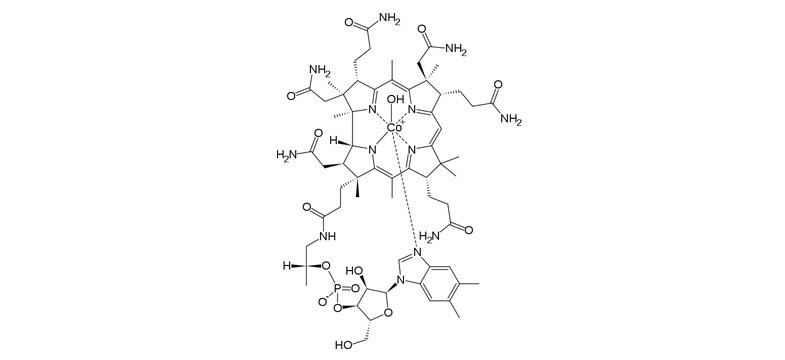Hydroxocobalamin: A Natural B12 Form
Hydroxocobalamin (also hydroxycobalamin) is a natural form of vitamin B12, which is produced by certain microorganisms and occurs in the body. It makes up almost half of all the vitamin B12 found in our blood. Of all the vitamin B12 forms, hydroxocobalamin is one of the most prevalent forms of the vitamin in natural foods (1).
In the body, hydroxocobalamin is converted into both of the bioactive coenzyme forms of B12 – methylcobalamin and adenosylcobalamin – the only two forms of the vitamin that the body can directly utilise.
While hydroxocobalamin itself is not a bioactive coenzyme form of B12 and must first be transformed, it has some notable advantages that set it apart from other B12 forms (such as artificial cyanocobalamin) and make it an interesting option for B12 supplements.
Hydroxocobalamin
- Natural B12 form
- Second most common form found in the blood
- Most prevalent B12 form in natural foods
Hydroxocobalamin Benefits: Detoxifying and Long Lasting
Hydroxocobalamin possesses certain outstanding health effects, which other B12 forms do not have.
Long Lasting with an Ideal Depot Effect
For one thing, hydroxocobalamin binds particularly well to the body’s transport molecules and as a result circulates in the blood much longer than any other B12 form. This ensures a long-lasting and uniform supply of the vitamin (2).
Hydroxocobalamin also has an excellent depot effect, which ensures both an even supply of B12 to the cells and that the body’s stores are optimally replenished. In this way, even periods of increased demand (e.g. through stress) can be compensated for by the body.
For high-dose initial therapy following a period of B12 deficiency, hydroxocobalamin is the option of choice.
Detoxifying
What is more, hydroxocobalamin has a special function even before it has been converted into the coenzyme forms: detoxification and disease prevention. Hydroxocobalamin is an outstanding cyanide scavenger and is therefore used, among other things, in the treatment of smoke poisoning (3). As a result, this active ingredient is an excellent option for people who are in the process of quitting smoking and detoxifying from smoke.
Nitrosative Stress Scavenger
At the same time, hydroxocobalamin is also a scavenger of nitric oxide (NO) radicals and thus an excellent remedy against what is known as nitrosative stress, believed to be the cause of a range of diseases. If you regularly take B12 supplement, you should therefore make sure that hydroxocobalamin is contained in addition to the active B12 forms. Although it is somewhat more expensive than cheap cyanocobalamin supplements, there are clear advantages of hydroxocobalamin and it matches the natural B12 profile found in foods.
Vitamin B12 Injections: Hydroxocobalamin vs Cyanocobalamin
Where the absorption of vitamin B12 is disturbed, for example in the case of many diseases and for those with gastrointestinal problems, it may be necessary to supply B12 via injections to circumvent absorption in the intestines. Injections are moreover a good aid for quickly refilling the body’s store after long periods of deficiency.
Here hydroxocobalamin is particularly advantageous because it is remarkably well absorbed by the body. In many countries, hydroxocobalamin is therefore the standard for vitamin B12 injections; compared to the synthetic alternative cyanocobalamin, the advantages of hydroxocobalamin are particularly clear (4):
| Hydroxocobalamin | Cyanocobalamin | |
| Natural form | Yes | No |
| No. of conversion steps to produce the coenzyme forms | 3 | 4 |
| Specific effects | Detoxifying cyanide, NO radical scavenger | No effect of its own |
| Absorption via injection | 70% | 20-50% |
| Depot effect | Very good | Inadequate |
Firstly, the uptake of hydroxocobalamin is much higher; secondly, it circulates much longer, while cyanocobalamin is excreted quite quickly. These two factors allow for much longer intervals between the individual B12 doses. For maintenance therapy, one injection every 3 months may be sufficient to cover the B12 requirement.
Hydroxocobalamin B12 Supplements: Pills and Capsules
These advantages are also very noticeable in oral supplements, such as pills or capsules, and the high absorption rate clearly shows how receptive the body is to this form. Even though the absolute amount of hydroxocobalamin that the body obtains from an oral supplement is limited by the rate of intestinal absorption – as with all other vitamin B12 forms; the excellent absorption and depot properties are significant advantages here (5).
When buying supplements, it is therefore advisable not to buy products with the cheaper, longer-lasting cyanocobalamin, but to make sure that the ingredients are as natural as possible. The optimal solution would be a mixture of hydroxo-, methyl- and adenosylcobalamin.
Hydroxocobalamin for Dexotification
As mentioned above, hydroxocobalamin is a very effective cyanide scavenger. Interestingly, it reacts with cyanide to form cyanocobalamin, which is then excreted by the body. In this context, cyanocobalamin is thus a detoxification product, which naturally raises the question of how useful it is to use as the main active ingredient in supplements. Smokers already have a higher presence of cyanide in their bodies and therefore hydroxocobalamin is a much better option for them than cyanocobalamin.
In addition to cyanide, hydroxycobalamin also binds with nitric oxide (NO), therefore reducing nitrosative stress – believed to be the cause of many diseases. Research is currently being conducted into the connections between nitrosative stress and diseases, such as: autoimmune diseases, neurodermatitis, psoriasis, asthma, heart attack, stroke, dementia, Alzheimer’s, Parkinson’s and cancer.
Different Types of Hydroxocobalamin B12
Hydroxocobalamin is very reactive, which is why it must be bound to a stabiliser as an active ingredient. Consequently, various types of hydroxocobalamin exist:
- Hydroxocobalamin acetate
- Hydroxocobalamin hydrochloride
- Hydroxocobalamin chloride
These active ingredients do not differ in effect, but some therapists report that hydroxocobalamin chloride significantly reduces the occurrence of acne caused by vitamin B12 – however, exactly how it does so has not yet been clarified.
Hydroxocobalamin – A Good Option for Vitamin B12 Therapy
In the body, hydroxocobalamin is the naturally-occurring precursor of the B12 coenzymes. Its common presence in foods explains why it is so well absorbed by the body. Plus, due to hydroxocobalaim’s very good depot effect, a long-lasting supply of B12 is ensured, making it one of the best options for vitamin B12 supplements.
For injections and in initial therapy following B12 deficiency hydroxocobalamin can be regarded as the first-choice ingredient; unfortunately, the bioactive forms are not available for injections in commercial supplements and can only be obtained from special pharmacies. In the case of oral supplements, hydroxocobalamin is also recommended – here combined with the two active forms.
Sources:
- Farquharson J, Adams JF. The forms of vitamin B12 in foods. Br J Nutr. 1976 Jul;36(1):127-36. PubMed PMID: 820366.
- Keith Boddy, Priscilla King, L. Mervyn, A. Macleod, J.F. Adams, Retention of cyanocobalamin, hydroxocobalamin, and coenzyme B12 after parenteral administration, The Lancet, Volume 292, Issue 7570, 28 September 1968, Pages 710-712, ISSN 0140-6736, http://dx.doi.org/10.1016/S0140-6736(68)90752-6.
- Shepherd G, Velez LI. Role of hydroxocobalamin in acute cyanide poisoning. Ann Pharmacother. 2008 May;42(5):661-9. doi: 10.1345/aph.1K559. Epub 2008 Apr 8.Review. PubMed PMID: 18397973.
- Hertz, H., Kristensen, H. P. Ø. and Hoff-JØrgensen, E. (1964), Studies on Vitamin B12 Retention Comparison of Retention Following Intramuscular Injection of Cyanocobalamin and Hydroxocobalamin. Scandinavian Journal of Haematology, 1: 5–15. doi: 10.1111/j.1600-0609.1964.tb00001.x
- Hall CA, Begley JA, Green-Colligan PD. The availability of therapeutic hydroxocobalamin to cells. Blood. 1984 Feb;63(2):335-41. PubMed PMID: 6692038.


